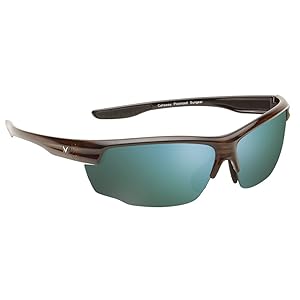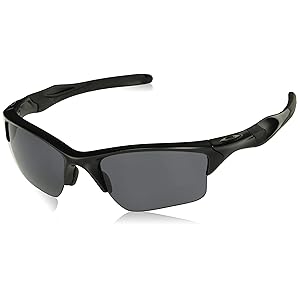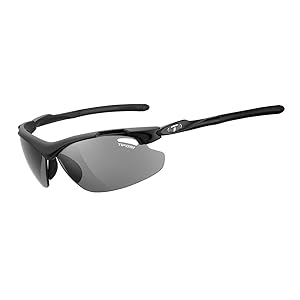Having to shield your eyes from glaring sunlight on the course is far from ideal and unfortunately all too common. For golfers who play in the morning or late evening, this is particularly problematic, with the sun often being directly in your line of sight.
A good pair of golf sunglasses can work wonders to make you more comfortable in judging distances and lining up your shots. The perfect pair of sunglasses for golf are comfortable enough to wear the whole day through, but snug enough to stay still on your face during your swing. You probably don’t want to spend all day reading about the benefits of various lens tints, so here are some quick recommendations for perfect golf sunglasses.
Continue reading to find a handful of individual golf sunglass reviews, along with a handy guide to choosing the right lens color and lens technology for your golfing eyewear.
The Best Golf Sunglasses

Golf sunglasses typically have a little more thought put into their design than your average sunglasses. Most notably, the varying lens tints work to block out specific types of light that interfere with your play. Choosing golf eyewear can be difficult, and many golfers will make the mistake of selecting a pair of sunglasses before understanding the particular purpose of the lens tint. Below are the best sunglasses for golf with lens tints to block out the majority of irritating light.
Oakley Flak 2.0 XL Golf Sunglasses
Oakley has established itself as a prominent player in golf eyewear. Their Flak 2.0 XL golf sunglasses are something of a flagship model, receiving wide praise from golfers and athletes in other sports alike. These “prizm” black polarized sunglasses do an incredibly effective job out on the course.
Dark gray or black lens tints retain close to 100% color correctness while sharpening focus in direct sunlight. This combination of contrast and true to life color makes vision seem natural even against the bright greens and blues of the grass and sky. A 100% UV protection coating also puts it at the forefront of UV protection in golf sunglasses, making them a perfect all-rounder.
Callaway Sungear Kite Golf Sunglasses
Callaway’s Sungear Kite golf sunglasses excel on the golf course. Designed with bright greens and blues in mind, the green mirror stacked on a gray lens works perfectly to keep the curves of the course visible and to make spotting golf balls very easy.
The fit of the eyewear is snug but comfortable, with adjustable node pads that help position them perfectly for maximum UV protection. You receive 100% UV protection from these glasses, which you’d expect given the rather premium price tag. All in all, these are fantastic golfing sunglasses that bear the name of a renowned golf brand; highly recommended.
Under Armour Igniter Polarized Golf Sunglasses
The Under Armour Igniter sunglasses for golfers feature the perfect tint color in our opinion. The gentle but deep brown-tinted polarized lens performs perfectly on the golf course in all light conditions. Their “multiflection” lens coating works to repel water and resists scratches and smudges, all while offering a 100% UV protection rating.
As for build quality, these Under Armour sunglasses leave nothing to be desired. They’re sturdier than the golf sunglasses of most other brands we’ve tried, and seem surprisingly light given the strength. We’re very impressed, and though the polarization does sometimes leave a glimpse of glare through, it’s actually pretty useful in highlighting the curves of the course at a distance.
Oakley Half Jacket 2.0 XL Golf Sunglasses
Oakley’s Half Jacket 2.0 golf sunglasses are one of the most widely praised pieces of eyewear available today. There’s good reason for it too; a very lightweight frame and excellent polarized lenses combine for an extremely comfortable experience. You can expect no less than 100% UV protection from premium Oakley sunglasses for golfers, and that’s what you get here.
It goes without saying that you pay for the privilege of the Oakley brand, so those on a budget may wish to look elsewhere. For the rest who are happy to spend that little bit extra to get what are probably the best golf sunglasses around, the price is absolutely justified.
Tifosi Tyrant 2.0 Golf Sunglasses
Tifosi Tyrant 2.0 sunglasses are perfect for golfers, and what’s more, they’re an absolute bargain. We’ve opted for the “all conditions” lenses rather than the extreme contrast variant since they seem to perform better over a whole day.
A 100% UV protection rating gives you all the sun protection you could ask for, and a smoky gray tint does a fantastic job of keeping colors correct while increasing contrast. The vented lenses allow for airflow that quickly removes any fogging, something we found ourselves wishing the more expensive brands had thought about including.
Bolle Bolt Sport Sunglasses
Bolle is a brand best known for its excellent sports gear, and their sports sunglasses are no different. These Bolt sunglasses are some of the best golf eyewear we’ve had the pleasure of looking through and are very competitively priced.
Bolle Bolt Sunglasses are incredibly comfortable and offer complete UV protection. They also feature an interchangeable lens system, which makes them a very good option for casual golfers, who may prefer to use a different lens tint when they’re not out on the course.
Understanding Golf Sunglasses And Lens Tints

You’ve likely landed here so we can do the job of figuring out which golf sunglasses are best, and which tints are most appropriate for different conditions. On the off-chance you’re interested in discovering more about how we came to these conclusions, we’re going to walk you through what separates the good from the bad. We’ll look at what each lens tint and technology does.
Best Lens Tints For Golf Sunglasses
The best lens tints for golf sunglasses are typically dark amber, copper or brown. Some golfers prefer deep greens and greys to reduce brightness even further.
Why is this the case? Let’s look at what each group of tints intends to do and how it applies to golf.
Light yellow or orange tints work to heighten contrast in low-light situations, such as indoor sports. They also filter out blue light, making your vision crisp and sharp. These are far too weak to block out the sunlight on a golf course effectively but could be appropriate on a very overcast day.
Amber, rose and red tints work best to block out light in slightly cloudy conditions. Unfortunately, they cause significant color imbalances, making them quite impractical against the bright green grass and blue skies of a golf course. This color imbalance is especially apparent when searching for a speck of white in the distance.
Dark amber, copper and brown tinted lenses are excellent for improving contrast on grass against blue skies – making them perfect for golf sunglasses. They block high amounts of blue light, allowing you to block out the brightness of the sky in favor of a clearer vision of the course.
Green tinted sunglass lenses are particularly good at maintaining color balance while blocking out a significant amount of light. Some golfers prefer green tints on extremely bright days.
Grey tinted lenses retain almost 100% of the natural color balance, meaning they’re the favored choice among people who prefer dimming the brightness of the scene without affecting colors.
Golf Sunglass Lens Technologies Explained
You’ll almost definitely have heard of polarized lenses at some point in your life. Photochromatic lenses, on the other hand, are less common. We’ll look at both lens technologies and help you choose correctly between them; ensuring you get a pair of golf sunglasses that fit your taste.
Polarized Golf Sunglasses
Polarized sunglasses lenses work to block light on horizontal wavelengths, meaning the glare of reflections is far less noticeable to the wearer.
Polarized golf sunglasses manage this reduction of glare effortlessly and maintain perfect color correctness in the process.
Polarization falls a little short when looking at screens, and can make mobile phones, rangefinders or other devices quite hard to see. A handful of golfers also find that reduced glare makes it more difficult to judge the curves of a golf course. This may be true, but it’s difficult to fault a technology for doing what it’s intended to do.
Overall, they’re an excellent choice for sports players because they consistently keep your vision crisp and clear.
Photochromatic Golf Sunglasses
Photochromatic golf sunglasses have lenses that automatically adjust to the light to darken when appropriate. These are most appropriate for golfers who are playing in changing light conditions.
As the day progresses and the level of sunlight changes on the course, photochromatic lenses will adapt seamlessly to ensure your vision stays clear.
The most common complaint by golfers regarding photochromatic golf sunglasses is that when the sun is low in the sky, the lenses darken drastically to reduce glare and impair vision on the green.
Which Lens Tint And Technology Is Best For Golf Sunglasses?
It’s difficult to put a definitive answer on something so subjective; however, we would lean towards dark amber, copper, or brown-tinted polarized lenses for most people.
The combination above is a happy medium that will offer an excellent reduction of glare and maintain color correctness on the course. Provided you get the fit right it’s very unlikely you’ll be dissatisfied with the performance of dark amber-tinted polarized sunglasses.
It’s a good idea to try out different tints at a store to get a feel for the effect they have on color and contrast. While the darker shades are typically more appropriate, it’s not a one-size-fits-all solution, and some may prefer the effect of lighter tints.






